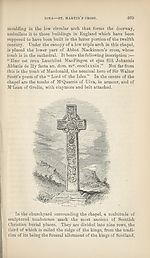Download files
Complete book:
Individual page:
Thumbnail gallery: Grid view | List view

ARGYLESHIRE,
Another sandy and low plain to the east contains the ancient
remains and the modern village. This plain is but of small
extent, and the soil, though arable, is of a light and sandy
quality, applicable almost only, and that by the assistance of
sea-weed, to the cultivation of barley and potatoes. A small
quantity of rye is grown ; but oats, as in similar soils else¬
where, do not succeed. The upland is a chequered mixture
of rocks and pasture, generally moorish, displaying, towards
its northern end, a mere labyrinth of rocks, among which it is
difficult to explore a way. A few ridges of corn are occasion¬
ally found in this upland where the soil is sandy ; but it is
chiefly pastured by black cattle ; which, together with kelp,
grown on the shores, and fish, in the taking of which the in¬
habitants display an industry unusual in this country, form
the disposable produce of the island. The population is 350,
the rent ,£300, and the land is divided into crofts. It is the
property of the Duke of Argyll. The steamer generally
anchors for about an hour in front of the village, which con¬
sists of a row of some forty huts, an established and free
church, with their respective manses and the parish school
(no inn). The passengers are taken ashore in small boats.
The Chapel of the Nunnery, now in a very ruinous state,
is the first place shown to strangers. Its architecture is the
second in order of antiquity, the arches being round, but with¬
out ornaments, and the whole style of the building partakes
of the general plan of the Norman churches before ornaments
came into use, but verges on the pointed arch, and other pecu¬
liarities which were introduced at a later period. Its date of
erection may be placed therefore beyond the twelfth century.
There is preserved here, an effigy of the last prioress Anna,
bearing the date 1543. The other half of the stone on which
the figure of the Virgin Mary was sculptured has been de¬
stroyed.
On the way from the Nunnery to St. Oran’s Chapel, by a
rude causeway, one of the two remaining crosses is passed. It
is called Mac Lean’s Cross, and consists of one stone eleven feet
high, covered with ornamental carved work.
St. Oran’s Chapel is Norman, but not of the highest anti¬
quity. The smallness of its scale, which is sixty feet by twenty,
its general rudeness, and the perpetual repetition of the chevron
Another sandy and low plain to the east contains the ancient
remains and the modern village. This plain is but of small
extent, and the soil, though arable, is of a light and sandy
quality, applicable almost only, and that by the assistance of
sea-weed, to the cultivation of barley and potatoes. A small
quantity of rye is grown ; but oats, as in similar soils else¬
where, do not succeed. The upland is a chequered mixture
of rocks and pasture, generally moorish, displaying, towards
its northern end, a mere labyrinth of rocks, among which it is
difficult to explore a way. A few ridges of corn are occasion¬
ally found in this upland where the soil is sandy ; but it is
chiefly pastured by black cattle ; which, together with kelp,
grown on the shores, and fish, in the taking of which the in¬
habitants display an industry unusual in this country, form
the disposable produce of the island. The population is 350,
the rent ,£300, and the land is divided into crofts. It is the
property of the Duke of Argyll. The steamer generally
anchors for about an hour in front of the village, which con¬
sists of a row of some forty huts, an established and free
church, with their respective manses and the parish school
(no inn). The passengers are taken ashore in small boats.
The Chapel of the Nunnery, now in a very ruinous state,
is the first place shown to strangers. Its architecture is the
second in order of antiquity, the arches being round, but with¬
out ornaments, and the whole style of the building partakes
of the general plan of the Norman churches before ornaments
came into use, but verges on the pointed arch, and other pecu¬
liarities which were introduced at a later period. Its date of
erection may be placed therefore beyond the twelfth century.
There is preserved here, an effigy of the last prioress Anna,
bearing the date 1543. The other half of the stone on which
the figure of the Virgin Mary was sculptured has been de¬
stroyed.
On the way from the Nunnery to St. Oran’s Chapel, by a
rude causeway, one of the two remaining crosses is passed. It
is called Mac Lean’s Cross, and consists of one stone eleven feet
high, covered with ornamental carved work.
St. Oran’s Chapel is Norman, but not of the highest anti¬
quity. The smallness of its scale, which is sixty feet by twenty,
its general rudeness, and the perpetual repetition of the chevron
Set display mode to:
![]() Universal Viewer |
Universal Viewer | ![]() Mirador |
Large image | Transcription
Mirador |
Large image | Transcription
| Antiquarian books of Scotland > Scotland/Scots > Black's picturesque tourist of Scotland > (588) |
|---|
| Permanent URL | https://digital.nls.uk/130035246 |
|---|
| Description | Thousands of printed books from the Antiquarian Books of Scotland collection which dates from 1641 to the 1980s. The collection consists of 14,800 books which were published in Scotland or have a Scottish connection, e.g. through the author, printer or owner. Subjects covered include sport, education, diseases, adventure, occupations, Jacobites, politics and religion. Among the 29 languages represented are English, Gaelic, Italian, French, Russian and Swedish. |
|---|

